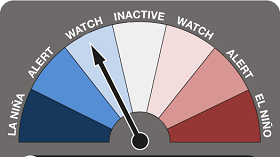When you run a small farm in Australia, you need to be prepared for increasingly regular severe weather events due to the La Nina and El Nino weather patterns.
Severe weather events such as floods and storms (during La Nina years) and drought and bushfires (during El Nino years) are risks that have become a certainty in Australia.
While we don’t know exactly when and where these events will take place, what we can do is be prepared and manage the impacts on our farm. No matter if you’re a new hobby farmer or manage an established lifestyle farm – managing these risks is crucial.
La Nina risks and certainties
Climate forecasting has given us more accurate forecasts of La Nina and El Nino events (which we used to call floods and droughts, or too wet and too dry).
For owners or managers of lifestyle farms, the timing of La Nina events can range from annoying to absolutely devastating. Severe storms and floods can happen just before harvest or planting, or when lambing, for example.
As small farm managers, we work with nature all the time, so it is a good idea to take heed of expert advice relating to La Nina events, for example from the weather bureau (BoM), Departments of Agriculture and consultants.

The key to best manage severe weather events is to have your risk management plan in place well before the next event, for it is a certainty; there is always going to be another one!
As Australia went into its third consecutive La Nina year in 2022, let’s cover the management of the amount, severity and timing of rain/water inundation, and the effects on your life, your livestock, property environment, infrastructure and business.
These events are not just floods, they also include storm damage to vegetation (wind, hail, etc.) and slope runoff (flash flooding) causing damage – such as erosion, dams bursting and landslips – affecting buildings, fences, roads, access tracks and more.
Managing La Nina risks on your small farm
Management steps a small landholder can take to limit the impact of La Nina include:
1. Develop a Risk Management Plan including climate and La Nina events.
2. Prepare or develop your property in line with your up-to-date Risk Management Plan.
3. Stay up to date with climate and weather forecasts.
4. Be proactive. It’s better to be safe than sorry!
5. Check that your farm insurance and other insurances are up to date and understand which weather events you are covered for.
6. Have an up-to-date and detailed inventory and valuation of everything that is insured, and keep it in a safe and accessible place.
Practical actions to prepare your farm for La Nina events
Here are some examples of specific actions you might take to prepare your small farm for La Nina weather events.
Long term:
1. Have infrastructure built or modified for La Nina events:
a. Well-designed fences and flood gates.
b. Electric fence cutout switches.
c. Contour bank system (Keyline) development to limit erosion.
d. Well-designed stock containment area(s). Chill effect can kill stock.
e. Access roads/tracks that are well formed & drained.
f. Water (creek) crossings that are well designed & made with depth indicators.
g. Removal of large trees that could fall on buildings.
2. Clean out infrastructure guttering and if replacing, install higher capacity drainage.
3. Build up the humus in your soil to limit erosion and runoff.
4. Always keep good ground cover to limit erosion.
5. Do not plough or disturb soil surface if possible.
6. Create well-placed and well-constructed levy banks around valuable infrastructure if in a flood plain.
Short term:
1. Be safe, be well planned, make good decisions, take good actions.
2. Do not drive through flood waters as floods can change the condition of the surface underneath considerably!
3. Have the SES, police and neighbours on speed dial on charged mobile phones.
4. Ensure all people involved know the plan and their responsibilities.
5. If it’s not safe to stay, everyone should leave before the event starts.
6. Move stock to high ground, with feed and water.
7. Remove your most important valuables to a safe place.
8. Check that your insurances are up to date and accessible.
9. Have sufficient stored feed and water in dry area(s) for family and stock.
10. Have access to a well-serviced and fueled generator/inverter.
Post event:
1. Look after yourself and others – physical and emotional wellbeing is paramount.
2. Check on stock health and keep animals in a relatively warm, dry place with feed and water.
3. Contact relatives and friends to let them know how you are and ask for help if needed.
4. Take a detailed survey of damage as soon as possible and document that with photos.
5. Contact your farm and general insurance agents – have their numbers on speed dial.
Recovery from a severe weather event will take time, effort and money and is an emotional time, so remember to look after yourself and others and don’t hesitate to ask for help.
Useful links:
• SES flood hazard information
• Flood management (Agriculture Victoria)
• BOM Flood Warning Services
These risk management articles are proudly bought to you by Farmstyle Insurance (flexible small farm insurance). For more information and to get a quote, visit Farmstyle Insurance.
About the Author
Malcolm Cock; Principal Consultant at Farm Dynamics Consulting, grew up on a dairy and beef farm in the Yarra Valley, Victoria. He has been working with small farm landholders for over 30 years to achieve their goals and has a vast amount of practical and theoretical farming experience.



